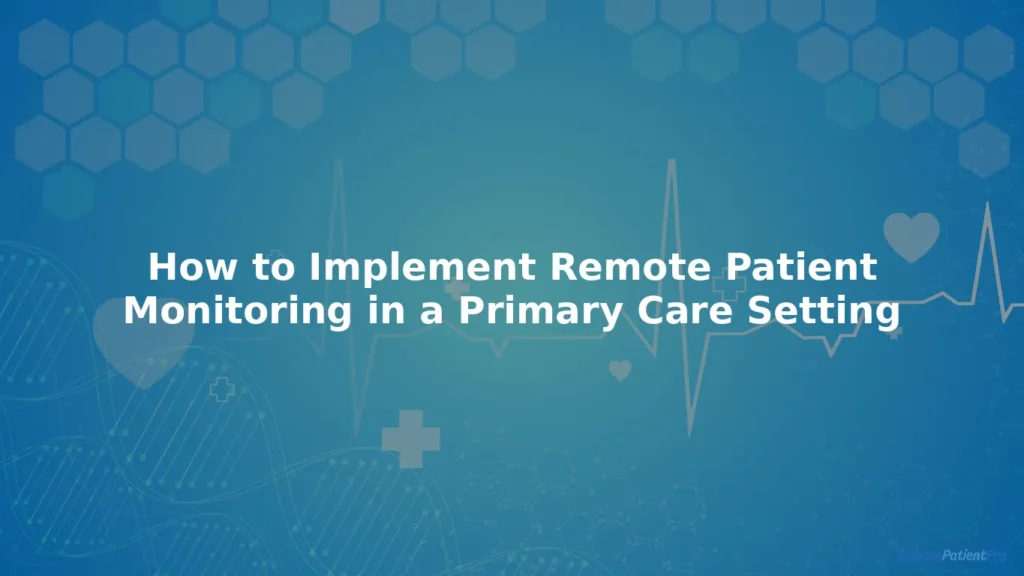How to Implement Remote Patient Monitoring in a Primary Care Setting
Remote patient monitoring (RPM) is a transformative tool for many practices, enabling real-time tracking of patient health data and proactive care management. By integrating RPM with your established workflows, you can improve outcomes and enhance patient engagement. However, effective implementation requires careful planning and the right tools. That’s why we provide end-to-end support to implement remote patient monitoring in primary care.
Benefits of RPM in a Primary Care Setting
- Improved Patient Outcomes
RPM provides real-time insights, enabling timely interventions that prevent complications. - Streamlined Workflows
Automated data collection and analysis reduce the administrative burden on healthcare teams. - Enhanced Patient Engagement
Patients actively monitor their health, fostering better adherence to treatment plans. - Proactive Chronic Disease Management
RPM supports continuous care for conditions like diabetes, hypertension, and COPD. - Increased Practice Revenue
Medicare and insurance reimbursements for RPM services create new revenue opportunities.
Steps to Implement Remote Patient Monitoring in Primary Care
1. Assess Your Practice’s Needs
- Identify the patient populations and conditions you aim to monitor, such as chronic diseases or post-acute care.
- Determine the specific goals for RPM, like reducing hospital readmissions or improving chronic disease management.
2. Select the Right RPM Platform
- Look for platforms that support real-time data tracking, customizable alerts, and integration with electronic health records (EHRs).
- Choose a HIPAA-compliant system to protect patient privacy.
3. Choose Compatible Monitoring Devices
- Equip patients with devices like blood pressure monitors, glucometers, and pulse oximeters.
- Ensure devices are easy to use and transmit data automatically to the RPM platform.
4. Train Your Team
- Provide training for clinicians and administrative staff on how to use the RPM system.
- Include best practices for monitoring, analyzing data, and responding to alerts.
5. Educate Patients
- Explain the benefits of RPM and train patients on how to use the devices and access their data.
- Provide ongoing support to address technical issues and encourage adherence.
6. Integrate RPM With Your EHR
- Sync RPM data with your existing EHR system for streamlined documentation and care coordination.
7. Monitor and Evaluate
- Regularly review RPM data to assess patient progress and adjust treatment plans as needed.
- Use analytics tools to track the program’s effectiveness and identify areas for improvement.
8. Leverage Reimbursement Opportunities
- Ensure your RPM services align with Medicare and insurance reimbursement codes.
- Automate billing processes to maximize efficiency.
The Bipartisan Policy Center discusses strategies to maximize the value of RPM, highlighting the importance of choosing the right monitoring devices.
Challenges of RPM Implementation and How to Overcome Them
1. Resource Constraints
- Solution: Start small by targeting high-risk patients and expand as you gain experience.
2. Patient Resistance
- Solution: Educate patients on the benefits of RPM and provide simple, easy-to-use devices.
3. Integration With Existing Systems
- Solution: Partner with an RPM provider like TriageLogic for seamless EHR integration.
4. Staff Adoption
- Solution: Offer comprehensive training and ongoing support to ensure staff confidence.
Key Features to Look for in an RPM System
- Real-Time Monitoring: Track vital signs and other health metrics continuously.
- Custom Alerts: Notify providers of abnormal readings for proactive intervention.
- User-Friendly Interface: Ensure ease-of-use for both providers and patients.
- HIPAA Compliance: Protect sensitive patient data with secure systems.
- Scalability: Choose a system that can grow with your practice.
- Reimbursement Support: Ensure the platform supports billing under Medicare codes.
Learn more about the guidelines for implementing RPM from the American Telemedicine Association.
How RemotePatientPro™ Supports RPM Implementation
TriageLogic’s RemotePatientPro offers a tailored RPM solution with expert support.
- Needs Assessment: We evaluate your practice’s requirements to recommend the best RPM platform and devices.
- Seamless Integration: We ensure a smooth integration with your EHRs and existing workflows.
- Training Programs: We deliver training to staff and patients on the effective use of RPM tools.
- Ongoing Support: We provide continuous technical and clinical assistance to optimize your RPM program.
Frequently Asked Questions
Q: How do I choose the right RPM platform for my practice?
A: Look for platforms that meet your specific needs, including real-time monitoring, EHR integration, and user-friendly features.
Q: Are RPM services reimbursable by Medicare?
A: Yes, many RPM services qualify for Medicare reimbursement, creating additional revenue streams for primary care practices.
Q: How does RemotePatientPro simplify RPM implementation?
A: We provide end-to-end support, from platform selection and integration to training and ongoing assistance.
Transform Your Primary Care Practice With RPM
Implementing remote patient monitoring can revolutionize how your practice delivers care. By leveraging RPM, you can enhance patient outcomes, streamline workflows, and reduce costs.
We’re here to guide you through every step of that process. Contact us today to learn more.

